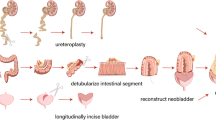Abstract
Aim
Ureteric stenting is widely used in open reimplantation, but not universal in pneumovesicoscopic reimplantation. Obstruction at the reimplant site due to early postoperative oedema is the main cause of concern. We present our experience in this regard.
Methods
Fifteen children with vesicoureteric reflux (VUR) who underwent pneumovesicoscopic Cohen’s reimplantation between 2019 and 2022 under a single surgeon were analyzed. Demographics, investigations, management details and outcome were collected retrospectively.
Results
Indications for reimplantation were recurrent urinary tract infection (UTI) with grade 3/4 reflux (9 unilateral and 5 bilateral). Few patients had associated conditions: one each of Fanconi’s anaemia, posterior urethral valves (PUV) with solitary functioning kidney, duplex system (common sheath reimplant done) and ipsilateral pelviureteric junction obstruction (PUJO) operated previously. Patients were not routinely stented. 3 patients were stented, based on single functioning kidney with renal impairment, immuno-compromised state or concern about the narrow neo-hiatus.
Among the 12 (22 ureters) non-stented children, 11 (20 ureters) had no complications. A 1.5-year-old male child with recurrent pyelonephritis, bilateral reflux (right—Grade 2, left—Grade 3), had anuria postoperatively for 20 h with uraemia. This resolved spontaneously (planned for percutaneous nephrostomy initially). Risk factors for reimplant obstruction in this child were recent pyelonephritis, persistent bladder mucosal inflammation at the time of surgery and lower grade reflux.
Conclusion
Pneumovesicoscopic reimplantation can be done safely without routine ureteric stenting. However, VUR with low-grade reflux without significant ureteric dilatation have the chances of ureteric obstruction, especially in the phase of residual bladder inflammation. Herein, stenting can be protective. We believe that presence of solitary kidney, renal impairment, re-do reimplant, tapering procedures and significant co-morbid conditions also warrant an elective stent insertion.



Similar content being viewed by others
References
Gill IS, Ponsky LE et al (2001) Laparoscopic cross-trigonal Cohen ureteroneocystostomy: novel technique. J Urol 166:1811–1814
Yeung CK, Sihoe JDY, Borzi PA (2005) Endoscopic Cross-trigonal ureteral reimplantation under carbon dioxide bladder insufflation: a novel technique. J Endourol 19:295–299
Canon SJ, Jayanthi VR, Patel AS (2007) Vesicoscopic cross-trigonal ureteral reimplantation: a minimally invasive option for repair of vesicoureteral reflux. J Urol 178:269–273
Patrick Ho Yu, Chung DY, Tang Y et al (2008) Comparing open and pneumovesical approach for ureteric reimplantation in pediatric patients- a preliminary review. J Pediatr Surg 43:2246–2249
Kawauchi A, Naitoh Y et al (2009) Transvesical laparoscopic cross-trigonal ureteral reimplantation for correction of vesicoureteral reflux: initial experience and comparisons between adult and pediatric cases. J Endourol 23:1875–1878
Lau CT, Lan LCL, Wong K-Y, Tam PKH (2017) Pneumovesical ureteric reimplantation in pediatric patients: an intermediate term result. J Laparoendosco Advanc Surg Tech. 27:203–205. https://doi.org/10.1089/lap.2016.0236
Jayanthi VR (2018) Vesicoscopic cross-trigonal ureteral reimplantation: high success rate for elimination of primary reflux. J Pediatr Urol 14:324.e1–324.e5. https://doi.org/10.1016/j.jpurol.2018.04.005
Kruppa C, Fitze G, Schuchardt K (2022) Vesicoscopic cross-trigonal ureteral reimplantation for vesicoureteral reflux: Intermediate results. Children 9:298. https://doi.org/10.3390/children9020298
Funding
No funds, grants or other support was received.
Author information
Authors and Affiliations
Corresponding author
Ethics declarations
Conflict of interest
The authors have no financial or non-financial interests to disclose.
Ethics approval
This is a retrospective observational study. The local ethics committee of Kanchi Kamakoti CHILDS Trust Hospital has confirmed that no ethical approval is required.
Rights and permissions
Springer Nature or its licensor (e.g. a society or other partner) holds exclusive rights to this article under a publishing agreement with the author(s) or other rightsholder(s); author self-archiving of the accepted manuscript version of this article is solely governed by the terms of such publishing agreement and applicable law.
About this article
Cite this article
Mahalingam, K., Sundararajan, L. Stenting in pneumovesicoscopic reimplantation: is it necessary?. J Ped Endosc Surg 5, 13–17 (2023). https://doi.org/10.1007/s42804-023-00179-8
Received:
Revised:
Accepted:
Published:
Issue Date:
DOI: https://doi.org/10.1007/s42804-023-00179-8




